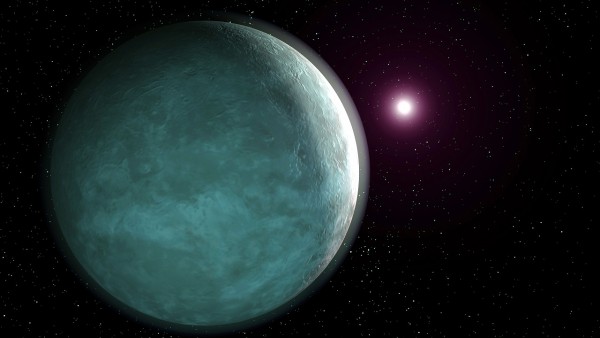Newly Discovered Icy Exoplanet could Explain Uranus and Neptune Mysteries
| Ana Verayo | | Oct 16, 2014 10:49 PM EDT |
(Photo : Wikimedia) Ice giants such as Uranus and Neptune possess a blue hue from the methane ice shrouding them.
For the first time, astronomers have discovered an ice giant exoplanet. This exoplanet in a solar system 25,000 light years away from Earth closely resembles Uranus.
Ice giants such as Uranus and Neptune consist mostly of helium and hydrogen and are shrouded by massive amounts of methane ice that make the planets appear blue in color.
Like Us on Facebook
Scientists can't determine if this exoplanet also possess a blue hue. There is confirmation, however, this exoplanet is indeed an ice giant since its orbital location around its sun is almost identical to that of Uranus.
Another remarkable attribute of this ice giant exoplanet is that it's located in a binary star system. The exoplanet's orbit is being disturbed or jostled by a second star that pulls on it from a different direction. This jostling might have contributed to the formation of the exoplanet.
This exoplanet probably holds the key to explaining mysteries about Uranus and Neptune.
It's still unclear why Uranus and Neptune are located on the outskirts of the solar system since they seem to have formed closer to the Sun, according to some theories.
A probable theory of why Uranus and Neptune are where they are today is they were jostled by bigger planets around them, Jupiter and Saturn. This jostling flung Uranus and Neptune into their present orbits.
This ice giant exoplanet, however is four times denser than Uranus and its location from its sun is similar to Uranus' distance from the Sun.
This exoplanet was discovered by gravitational microlensing, a phenomenon where gravitational forces bend light between objects, thereby magnifying objects far away. The Warsaw Telescope in Chile detected and observed this microlensing event that magnified light 25,000 light years from Earth.
Microlensing allows astronomers and scientists to detect immensely distant worlds and gather information such as a planet's mass and composition, along with its orbital location from its star.
TagsNew Uranus Ice Giant Exoplanet Found by Astronomers 25, 000 Light Years Away, Uranus, Neptune, ice giant, new planet uranus ice giant
©2015 Chinatopix All rights reserved. Do not reproduce without permission
EDITOR'S PICKS
-

Did the Trump administration just announce plans for a trade war with ‘hostile’ China and Russia?
-

US Senate passes Taiwan travel bill slammed by China
-

As Yan Sihong’s family grieves, here are other Chinese students who went missing abroad. Some have never been found
-

Beijing blasts Western critics who ‘smear China’ with the term sharp power
-

China Envoy Seeks to Defuse Tensions With U.S. as a Trade War Brews
-

Singapore's Deputy PM Provides Bitcoin Vote of Confidence Amid China's Blanket Bans
-

China warns investors over risks in overseas virtual currency trading
-

Chinese government most trustworthy: survey
-

Kashima Antlers On Course For Back-To-Back Titles
MOST POPULAR
LATEST NEWS
Zhou Yongkang: China's Former Security Chief Sentenced to Life in Prison

China's former Chief of the Ministry of Public Security, Zhou Yongkang, has been given a life sentence after he was found guilty of abusing his office, bribery and deliberately ... Full Article
TRENDING STORY

China Pork Prices Expected to Stabilize As The Supplies Recover

Elephone P9000 Smartphone is now on Sale on Amazon India

There's a Big Chance Cliffhangers Won't Still Be Resolved When Grey's Anatomy Season 13 Returns

Supreme Court Ruled on Samsung vs Apple Dispute for Patent Infringement

Microsoft Surface Pro 5 Rumors and Release Date: What is the Latest?










